Estimating Rice Panicle Temperature with Three-Layer Model
Abstract
Rice panicle temperature (Tp) is a key factor for studying high temperature impacts on spikelet sterility. Comparing with measuring Tp by hand, a Tp simulation model could obtain Tp data readily. The two-layer energy budget model which divides the soil layer and canopy layer was widely used to predict rice canopy temperature (Tc), but panicle existed mostly in the upper layer canopy, and we have proved that Tc was different from the upper layer canopy temperature (Tc1), and the upper layer must be separated from the whole canopy for the purpose of estimating Tp. Thus, we developed the three-layer model, contained upper canopy layer with panicle (50–100 cm), lower rice canopy layer (10–40 cm), and water surface layer (≤10 cm) to estimate Tp with general meteorological and vegetation growth data. There were two steps to estimate Tp. The first step was calculating Tc1 and lower layer canopy temperature (Tc2) by solving heat balance equations with canopy resistances. And the second step was estimating Tp with following parameters: (a) the inclination factors of leaves and panicles (F1, F2, and Fp) which were decided by fitting the calculated transmissivity of downward solar radiation (TDSR) to the measured TDSR, (b) the aerodynamic resistance between the panicle and atmosphere (rap) denoted by wind speed, (c) the panicle resistance for transpiration (rp) denoted by days after heading, and (d) air temperature and humidity at the panicle’s height (Tac1 and eac1) calculated from the resistances of the pathways of sensible and latent heat fluxes in accordance with Ohm’s law. The model simulated fairly well the Tc1, Tc2, and Tp with root mean square errors (RMSEs) of 0.76°C, 0.75°C, and 0.81°C, respectively, where RMSE of measured Tp and predicted Tp by integrated micrometeorology model for panicle and canopy temperature (IM2PACT) including two-layer model was 1.27°C. This model was validated well by two other rice cultivars, and thus, it demonstrated the three-layer model was a new feasible way to estimate Tp.
1. Introduction
With increasing concerns about global warming, the impacts of higher temperature on rice production have become a major focus in many rice-producing countries in tropical, subtropical, and temperate regions [1–9]. In China, extreme high temperature in 2003 caused about 5 million tonnes of rice yield loss [10], while unusual temperatures (>40°C) in many areas of Kanto and Tokai regions of Japan resulted in 25% spikelet sterility in 2007 [11].
Rice panicle is most sensitive to high temperature during the flowering stage [12–16]. It has been proved that high temperature prevents anther dehiscence and decreases basal pore length of the anther, resulting in low numbers of germinating pollen grains on the stigma, and thus, it causes spikelet sterility [7, 12, 15, 17–22].
Effect of high temperature on spikelet sterility has been studied under different conditions. Matsui et al. [23] reported that spikelet fertility was significantly damaged when daily maximum air temperature exceeded 35°C. Abeysiriwardena et al. [24] revealed high temperature condition (35°C day/30°C night) induced complete grain sterility when relative humidity (RH) was 85–95%. Contrary to the results above, [25, 26] demonstrated spikelet sterility of rice did not occur seriously even daily maximum Ta was over 40°C in Australia during the 2004–2006 growing seasons because the strong transpirational cooling by low relative humidity (<20%) brought panicle temperature (Tp) 6.8°C lower than Ta. But spikelet sterility occurred frequently in Jianghan Basin, China, where Ta was not so high, since Tp was 4.0°C higher than Ta under high solar radiation with high RH (>80%) and low wind speed (u < 1 m s−1) conditions [27]. Therefore, Tp instead of Ta is a key factor for high temperature impact study. As measuring Tp was a time-consuming and laborious work, a Tp simulation model was needed to obtain Tp data readily.
Until now, only limited information has been reported about panicle temperature models. Sheehy et al. [28] developed a Tp model with air temperature and thermal burden. Oue et al. [29] measured Tp in every 10 cm rice canopy layer in the CO2 ambient and CO2 elevated plots during the daytime in Wuxi, China, and developed a heat balance model of Tp based on the measured stomatal conductance. To date, the whole canopy temperature (Tc) predicted by the two-layer model has been used to calculate the long-wave radiations to the panicle as shown in the integrated micrometeorology model for panicle and canopy temperature (IM2PACT) [30]. However, panicle exists mostly in the upper layer canopy, and we have proved that Tc is different from the upper layer canopy temperature (Tc1), and the upper layer must be separated from the whole canopy for the purpose of estimating Tp, whereas the multilayer model [31] required many vertical profiles of micrometeorological environments and fluxes of momentum, and heat and vapor within and above a vegetation, making it unusable to predict Tp with insufficient data.
Therefore, the objectives of this paper are (1) to develop a three-layer model to calculate panicle temperature based on general meteorological and vegetation growth data and (2) to compare the performance to estimate Tp by three-layer model and Tp by IM2PACT [30] including two-layer model.
2. Materials and Methods
2.1. Measurements in the Rice Paddy Field
The experimental paddy field was located in the Ehime University Senior High School, Matsuyama, Japan (33°50′N, 132°47′E). The Japonica type rice (cultivar Akitakomachi) was transplanted with 20 × 30 cm spacing on May 27, 2014, and then harvested on September 8, 2014.
The global solar radiation (St), downward long-wave radiation (Ld), and upward long-wave radiation (Lu) above the rice canopy were detected using pyranometer CNR-4 (Kipp & Zonen, the Netherlands) at 2.0 m height from the ground. To measure soil heat flux (G), a soil heat plate CHF-HDP01 (Campbell Scientific Inc., Logan, UT, USA) was buried in the soil surface. Air temperature (Ta) and relative humidity (RH) were observed using ventilated psychrometers HMP-45A (Vaisala Inc., Helsinki, Finland), first mounted at 0.6 m and 1.0 m of a 2.5 m tower, and then lifted to 1.0 m and 1.5 m on July 28, respectively, when rice plant was 81 cm in height. Three-cup anemometers 014A (MetOne, USA) were mounted as the same heights of psychrometers to measure the wind speed (u). Downward and upward long-wave radiations beneath the rice canopy were both measured with PRI-01 (Prede, Japan) sensors. Water surface temperature (Tw) or ground surface temperature (Tg) was measured with the thermocouple sensor. All data were sampled per 10 s; then, they were averaged and recorded per 10 min using a data logger CR23x (Campbell Scientific Inc., Logan, UT, USA).
Three stubs of rice were taken to measure the upper layer canopy temperature (Tc1), the lower layer canopy temperature (Tc2), and the panicle temperature (Tp) per 2 or 3 h in the daytime using an infrared thermometer THI-500 (Tasco, Japan). The solar radiation within rice canopy was measured with a line type pyranometer PCM200 (Prede, Japan) in the center between stubs in parallel and perpendicular directions, of which the average was calibrated from the solar radiation measured with CNR-4 (Kipp & Zonen, the Netherlands) at 2.0 m. The transmissivity of downward solar radiation (TDSR) refers to the ratio of the St in the rice canopy in every 10 cm to that above the rice canopy. Subsequently, the average TDSRs from 50 cm to 100 cm and from 10 cm to 40 cm were set as the upper and lower layer rice canopy TDSRs, respectively. TDSRs were measured from 10 cm to the top of the canopy per 10 cm and 1.2 m (above the rice canopy). The canopy temperature, Tp, and solar radiation within canopy data were recorded using ZR-RX 20 portable multilogger (Omron, Japan). At the heading and the flowering stage, irrigation was performed in the paddy field at 5-day interval. Besides, 8 cm depth irrigation water decreased to 0 through evaporation and infiltration in one and a half days. At the ripening stage, there was almost no water.
Plant area density (PAD) was sampled three rice plants at the interval of one week. The taken three rice plants were cut at intervals of 10 cm, split into components of leaves, stems, and panicles, respectively, and then scanned. Lastly, the area of each part (projected area for panicle) was calculated using ImageJ software. Water depth (dw) was measured per two or three hours in the daytime. Water surface evaporation (Eg) beneath the rice canopy was measured with the lysimeter (length × width × depth: 60 × 20 × 30 cm) and recorded twice (8:30 and 18:30) per day.
2.2. Estimating Panicle Temperature (Tp) with Three-Layer Model
The input data of the three-layer model to estimate Tp include (a) hourly radiations, (b) temperature, humidity, and wind speed, (c) water surface data, and (d) vegetation growth data. Tp was estimated in two steps. The first step was calculating Tc1 and Tc2 by solving heat balance equations with canopy resistances and the second step was estimating Tp with calculated Tc1 and Tc2.
The schematic of the aerodynamic resistance and upper and lower layer canopy resistances of one-layer and three-layer models is illustrated in Figure 1. The schematic diagram illustrating the method for estimation Tc1, Tc2, and Tp by the three-layer model is shown in Figure 2. And the input parameters required for the calculation in the model are shown in Table 1.
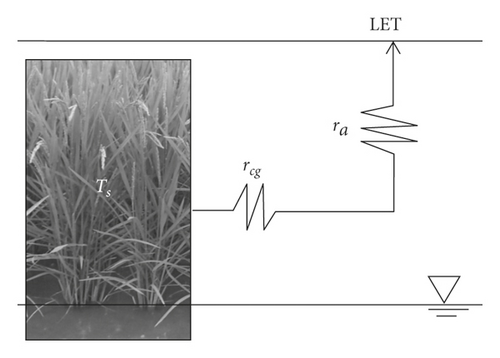
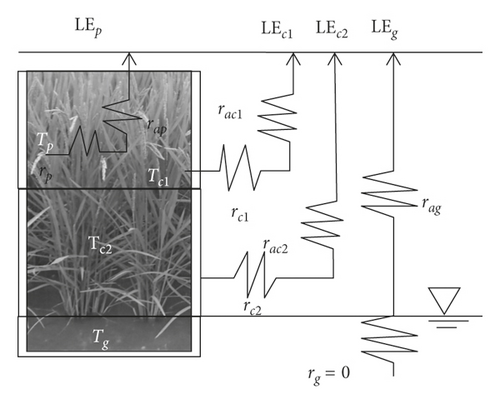
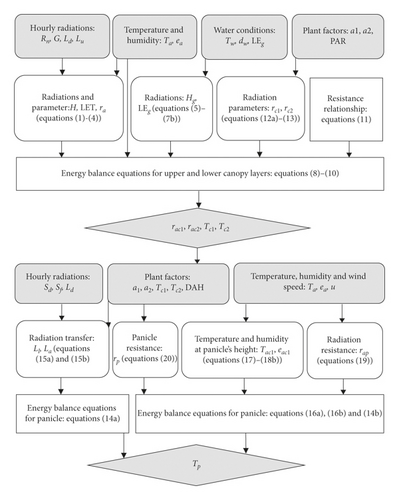
| Symbol | Name | Unit |
|---|---|---|
| Forcing parameters | ||
| Rn | Net radiation for the whole canopy | W m−2 |
| G | Soil heat flux | W m−2 |
| Ld | Downward long-wave radiation for the whole canopy | W m−2 |
| Lu | Upward long-wave radiation for the whole canopy | W m−2 |
| Ta | Air temperature | °C |
| ea | Water vapor pressure of the air | hPa |
| u | Wind speed | m s−2 |
| Ground characteristics | ||
| Tw | Water temperature | °C |
| dw | Water depth | m |
| LEg | Latent heat flux between water surface beneath canopy and atmosphere | W m−2 |
| Canopy characteristics | ||
| a1 | Green leaf and yellow leaf area index in the upper canopy layer | m2 m−3 |
| a2 | Green leaf and yellow leaf area index in the lower canopy layer | m2 m−3 |
| PAR | Photosynthetically active radiation | μ mol m−2 s−1 |
| gs | Stomatal resistance | cm s−1 |
- Note: gs was referred to Oue’s literature [32]; other data were observed.
Based on the data of measured G, δW, LE, and H were calculated by equation (1), and Ts was obtained by equation (4). Subsequently, ra was obtained by equation (3b), and lastly rcg was calculated by equation (3c) based on the data of measured Ta, ea, and LET.
| Date | Canopy layer | VPD (hPa) | ms (cm s−1)/(μ mol m−2 s−1) | gsmax (cm s−1) |
|---|---|---|---|---|
| August 6 | Upper | ∼18 | 0.00247 | 1.500 |
| 18∼ | 0.00170 | 0.500 | ||
| Lower | ∼10 | 0.002405 | 1.500 | |
| 10∼15 | 0.002095 | 1.200 | ||
| 15∼ | 0.001925 | 0.800 | ||
| August 13 | Upper | ∼8 | 0.00780 | 0.820 |
| 8∼ | 0.01246 | 0.410 | ||
| Lower | ∼8 | 0.009935 | 0.515 | |
| 8∼ | 0.00833 | 0.470 | ||
| August 27 | Upper | ∼9 | 0.00282 | 0.500 |
| 9∼ | 0.00195 | 0.400 | ||
| Lower | ∼10 | 0.003155 | 0.900 | |
| 10∼11 | 0.00261 | 0.750 | ||
| 11∼ | 0.00213 | 0.450 | ||
| September 4 | Upper | ∼16 | 0.003475 | 0.550 |
| 16∼ | 0.000445 | 0.400 | ||
| Lower | ∼15 | 0.001315 | 0.400 | |
| 15∼16 | 0.00123 | 0.400 | ||
| ∼16 | 0.00615 | 0.400 | ||
- Note: VPD is vapor pressure deficit, gs is the stomatal conductance (cm s−1), gsmax is the maximum of stomatal conductance (cm s−1), gsmin is the minimum of stomatal conductance (cm s−1), and ms and ns are parameters.
With the calculated rc1 and rc2, Tc1, Tc2, rac1, and rac2 were calculated by equations (8)–(10c).
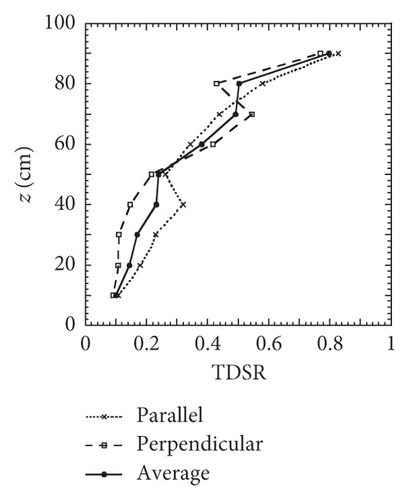
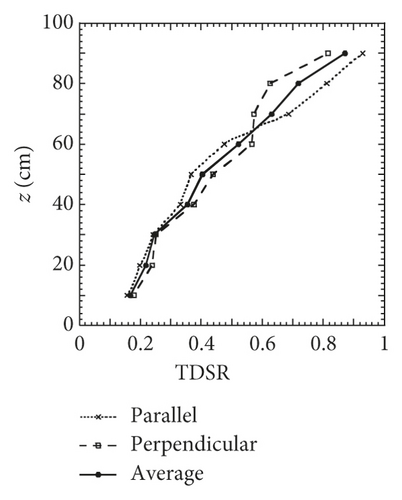
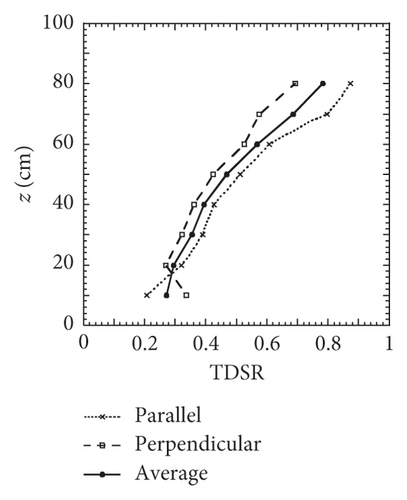
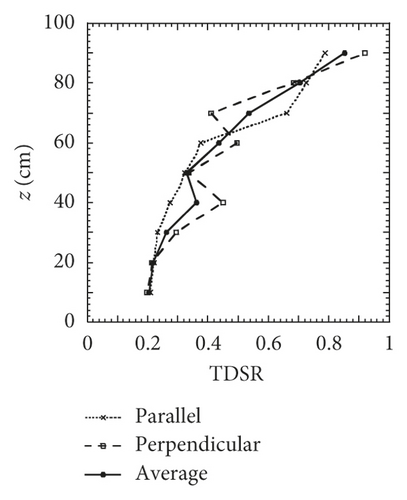
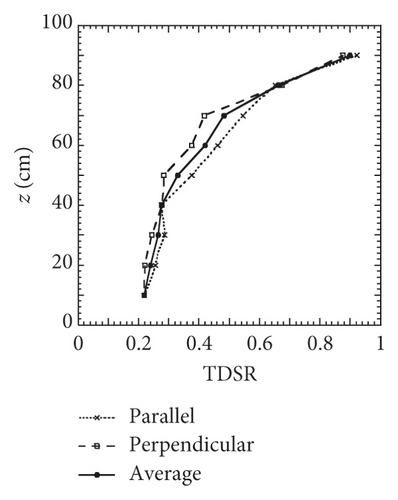
The average value of measured panicle temperature from 50 cm to 100 cm was set as the measured Tp, which was compared with the Tp using the three-layer model and by IM2PACT [30] including the two-layer model.
2.3. Statistical Analysis of Models
The measured and calculated Tc1, Tc2, and Tp were compared by using error analysis and linear regression. Root mean squared error (RMSE), mean absolute error (MAE), and the standard deviation (SD) [33–35] were adopted to evaluate measured and calculated Tc1, Tc2,Tc, and Tp by the models.
2.4. Three-Layer Model Validation
We planted rice (cultivar Hinohikari) from June 21 to November 20, 2015, and rice (cultivar Nikomaru) from June 21 to November 27, 2015, in the same paddy field. PAD of two cultivars was both measured from July 9 to October 14, 2015. Other meteorological instruments were set as same as 2014. Six images were taken to get Tc and Tp by infrared thermometer FLIR-i5 (FLIR systems, USA) at different heights every two or three hours during daytime.
3. Results and Discussion
3.1. General Meteorological Conditions
From July 18 to September 8, the daily average global solar radiation (St) was 262 W m−2, the average air temperature (Ta) was 25°C, while the highest Ta was 35°C on July 26, 2014. The average relative humidity (RH) was 81%, and the average wind speed (u) at 1.0 m reached 0.5 m s−1. The total precipitation, the total evapotranspiration, and the daily evapotranspiration were 670 mm, 567 mm, and 5 mm, respectively.
3.2. Plant Area Density (PAD)
Panicles’ height ranges from 50 cm to 100 cm, and this part of the rice plant was set as the upper canopy layer. There was no panicle on July 18, and the heading was observed on July 25 (Figure 4). The average of the measured green leaf and yellow leaf area index in the upper layer rice canopy (a1) ranged from 50 cm to 100 cm, which reached its peak on August 8 (2.5) and then decreased. However, green leaf and yellow leaf area index in the lower layer rice canopy (a2) decreased from 3 on July 25 to 1.5 on August 8, 2014.
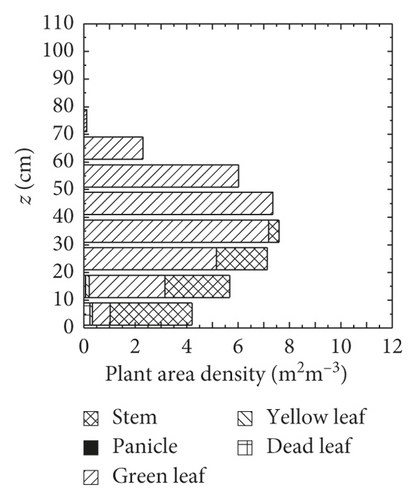
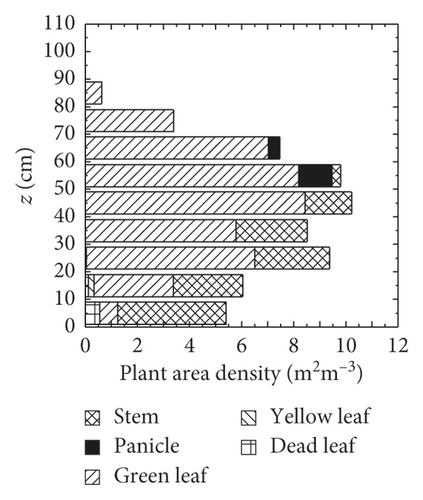
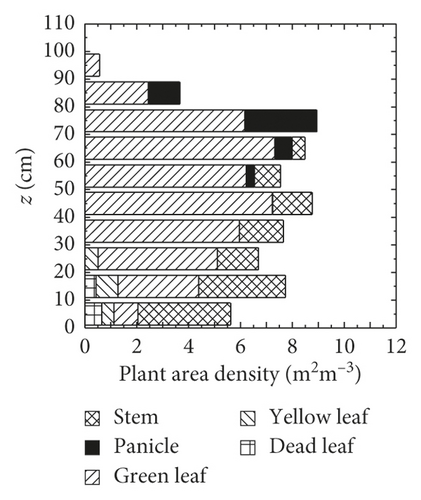
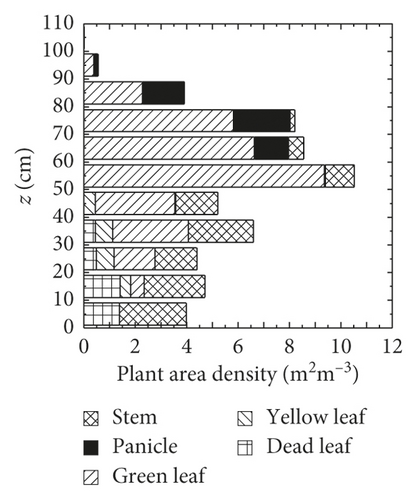
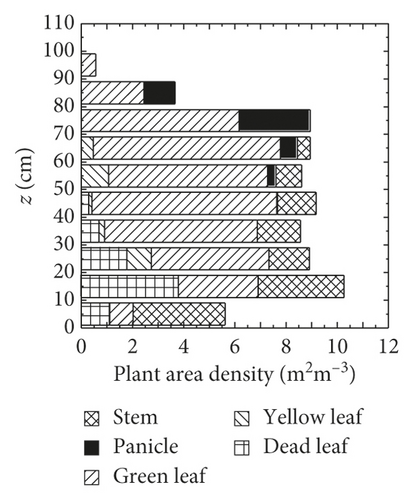
3.3. Modeling Parameter Results
3.3.1. Parameters F1, F2, and Fp
From August 5 to September 7 in the ripening stage, there was a little diurnal variation of rice morphology.
F1 was smaller than F2 because the transmissivity of solar radiation was larger in the upper layer, and the leaf area index of the upper layer canopy (a1) was also bigger than that in the lower layer (a2). For example, a1 was 2.5 and a2 was 1.5 on August 8. F1 and F2 were larger in the morning and afternoon than those at noon, respectively. This was because of the different solar radiation altitudes: in the morning and afternoon, the solar altitude was low, and the solar radiation in the upper layer was large after cutting off, and at noon, the solar radiation was the highest, and the solar radiation in the upper layer was smaller after cutting off. This was dependent on the morphology of canopy: leaves stood upright from 60 cm to 100 cm in the upper layer. In the lower layer, in the morning and afternoon, the solar radiation coming diagonally would be cut off by leaves, while at noon, the solar radiation coming from overhead would not be largely cut off, thereby leading to the smaller F1 and F2 during this period.
Fp was important after the ripening stage, when the panicles hung their heads and cover the top of the canopy [36]. Fp variation was similar to that of F1 from morning to afternoon because of the similar form of panicles and leaves.
F1 and F2 were smaller than the leaf inclination factor (F) in the ripening stage published by Maruyama et al. [37]. To estimate the radiation exchange processes in the rice canopy, the hourly variation of F1, F2, and Fp should be considered for accuracy.
3.3.2. Aerodynamic Resistance between the Panicle and Atmosphere (rap)
Table 3 lists the aerodynamic resistance between the panicle and atmosphere (rap) and meteorological data when rp was set as 0: there was rain before, or dew was found in the morning (August 5, 7, 18, 26, and 28).
| Date | Time | Tp (°C) | Tac1 (°C) | u (m s−1) | rap (s m−1) |
|---|---|---|---|---|---|
| August 5 | 8:30 | 26.8 | 27.8 | 0.4 | 18.1 |
| August 7 | 8:30 | 26.8 | 28.4 | 0.6 | 10.9 |
| August 18 | 8:30 | 26.3 | 26.9 | 0.6 | 10.9 |
| August 26 | 9:30 | 26.1 | 27.6 | 1.7 | 6.2 |
| August 28 | 8:30 | 24.7 | 25.1 | 0.6 | 12.4 |
- Note: rap is the aerodynamic resistance to the transfer of sensible heat between panicle and atmosphere, Tp is the panicle temperature, Tac1 is the air temperature at the panicle’s height, and u is the wind speed.
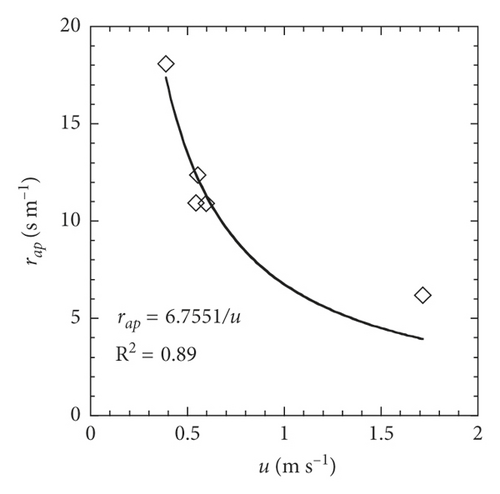
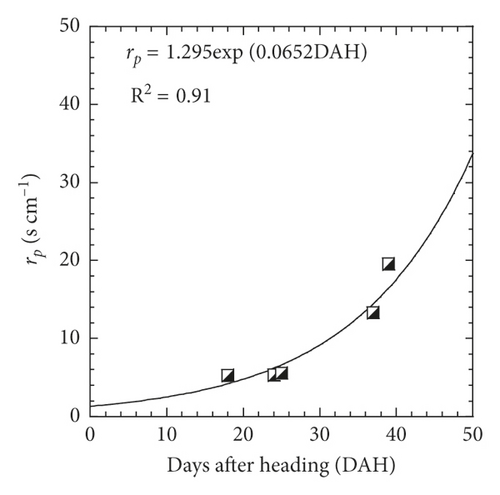
The friction of the panicle-atmosphere surface could be weakened by the wind speed, and the transport of heat and water vapor between panicle and atmosphere was primarily attributed to molecular diffusion.
Since from August 5 to September 7, the plant height and PAD only had little difference, and the effect of the canopy structure was not considered for rap in this study.
3.3.3. Panicle Resistance for Transpiration (rp)
Based on the measured average Tp from 50 cm to 100 cm and rap calculated by Eq. (19), rp can be calculated by equations (16a) and (16b). Five days under large St, high Ta and low RH conditions meaning strong transpiration (August 12, 18, 19, and 31 and September 2) were selected to analyze the influence of rp (Table 4).
| Date | Time | DAH | St (W m−2) | Ta (°C) | u (m s−1) | RH (%) | rp (s m−1) |
|---|---|---|---|---|---|---|---|
| August 12 | 14:30 | 18 | 773 | 29 | 1.4 | 70 | 5.3 |
| August 18 | 11:10 | 24 | 662 | 31 | 1.2 | 68 | 5.4 |
| August 19 | 10:30 | 25 | 748 | 33 | 1.6 | 60 | 5.6 |
| August 31 | 13:00 | 37 | 711 | 29 | 1.4 | 65 | 13.3 |
| September 2 | 11:30 | 39 | 761 | 29 | 1.1 | 67 | 19.6 |
- Note: DAH is days after heading, St is solar radiation, Ta is the air temperature, RH is the relative humidity, u is the wind speed, and rp is the panicle transpiration resistance.
Thus far, though there was rare information about rp, few researchers have measured the transpirational conductance gp (=1/rp) in rice paddy fields. Our results showed a similar variation but smaller values compared with those of cultivar “Wuxiangjing 9” reported by Oue et al. [29], in which gp decreased with the increase in DAH from 0 to 9 under both ambient CO2 and free air CO2 enrichment condition.
This new useful method was presented in this study to denote rp as a parameter by DAH, while some other methods were reported. In the integrated micrometeorology model for panicle and canopy temperature (IM2PACT) developed by Yoshimoto et al. [30], gp denotes the parameter of the relative humidity in the vicinity of panicle (RHac), which was not easily and accurately measured with the ordinary ventilated psychrometers. Based on the measurements of rice varieties at the time of flowering, Fukuoka et al. [39] presented three regression equations of gp as a function of vapor pressure deficit (VPD).
3.4. Modeling Tp
The differences between Tc1 and Tc2 were presented by Wang et al. [40]. The average values of measured canopy temperature from 50 cm to 100 cm and from 10 cm to 40 cm were set as the measured Tc1 and Tc2, which were then compared with the modelled ones, as shown in Figures 6(a) and 6(b). The root mean square errors (RMSE) of modelled Tc1 and Tc2 were 0.76°C and 0.75°C. Besides, the difference between modelled and measured Tc1 and Tc2 ranged from −1.69°C to 1.35°C and from −1.50°C to 1.61°C, respectively. According to results of the 2-tailed t-test statistical analysis, the modelled Tc1 and Tc2 values were not significantly different from the measured values at the 0.05 probability level.

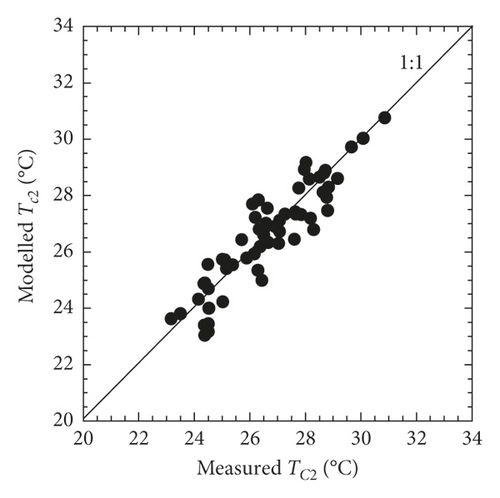
In this study, we set Tc = (Tc1 × a1 + Tc2 × a2)/(a1 + a2), and measured Tc was compared with that estimated by the two-layer model developed by Yan and Oue [38], as shown in Figure 7(a). RMSE of Tc by our three-layer model was 0.63°C, smaller than that by the two-layer model (1.21°C).
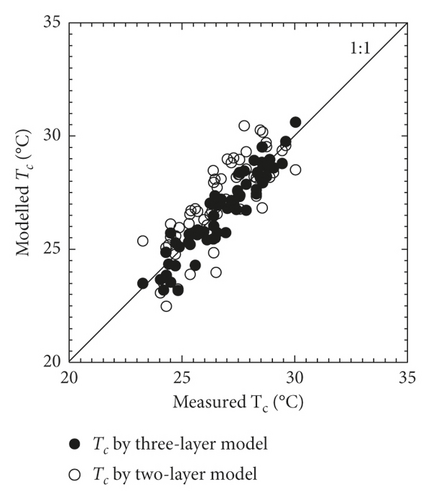
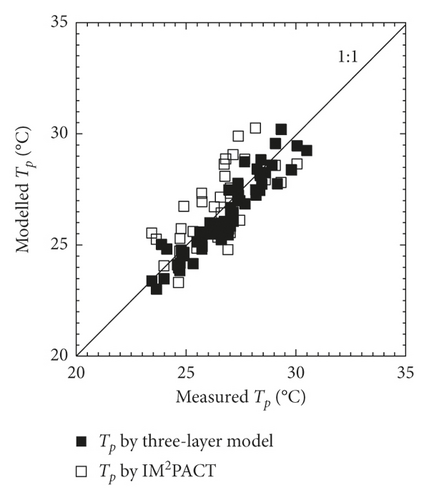
As shown in Figure 7(b), RMSE of Tp estimated by the three-layer model was 0.81°C, smaller than that estimated by IM2PACT (1.27°C) including the two-layer model. Better agreements between the measured and modelled Tp by the three-layer model than that by IM2PACT were obtained, particularly under high Ta conditions as shown in Table 5. This was because (1) Tc1 instead of Tc was used to predict Tp, since modelled Tc1 could be 3°C different with modelled Tc; (2) F1, F2, and Fp were determined by fitting the calculated TDSR to the measured TDSR, F1, F2, and Fp varied with time because of the different solar radiation altitudes: rather than set to be constant; and (3) rp denotes the parameter of measured Tp by DAH which considering transpiration cooling instead of the RHac.
| Date | Time | St (W m−2) | Ta (°C) | RH (%) | Tc (°C) | Tc1 (°C) | Tp by IM2PACT (°C) | Tp by three-layer model (°C) | Mea Tp (°C) |
|---|---|---|---|---|---|---|---|---|---|
| August 5 | 9:00 | 212 | 28 | 80 | 26.7 | 26.2 | 28.9 | 26.6 | 26.8 |
| August 5 | 14:00 | 201 | 30 | 71 | 28.1 | 26.9 | 27.6 | 26.9 | 27.0 |
| August 11 | 11:00 | 671 | 27 | 73 | 28.9 | 25.5 | 27.0 | 25.2 | 25.7 |
| August 18 | 9:00 | 235 | 27 | 84 | 26.3 | 25.8 | 26.7 | 26.2 | 26.3 |
| August 18 | 12:00 | 599 | 31 | 68 | 26.8 | 29.5 | 27.4 | 28.4 | 28.4 |
| August 18 | 15:00 | 485 | 32 | 68 | 28.5 | 26.7 | 29.7 | 28.8 | 28.7 |
| August 19 | 9:00 | 477 | 32 | 66 | 28.2 | 26.1 | 29.8 | 28.5 | 28.9 |
| August 19 | 14:00 | 745 | 32 | 66 | 28.5 | 30.5 | 28.6 | 29.6 | 30.1 |
| August 19 | 16:00 | 541 | 33 | 59 | 28.5 | 28.9 | 28.5 | 29.3 | 29.1 |
| August 20 | 17:00 | 188 | 29 | 77 | 28.3 | 26.4 | 28.9 | 27.8 | 27.7 |
| August 20 | 18:00 | 80 | 29 | 78 | 27.7 | 25.1 | 27.2 | 26.5 | 26.6 |
| August 26 | 12:00 | 474 | 29 | 67 | 27.6 | 26.5 | 25.7 | 27.4 | 27.0 |
| August 26 | 15:00 | 442 | 30 | 69 | 28.2 | 26.4 | 30.3 | 27.5 | 28.1 |
| September 3 | 15:00 | 86 | 29 | 70 | 27.2 | 25.2 | 29.1 | 26.5 | 27.1 |
| September 6 | 10:00 | 474 | 29 | 71 | 26.7 | 24.9 | 28.1 | 25.7 | 26.7 |
| September 6 | 16:00 | 93 | 28 | 76 | 29.3 | 28.8 | 27.8 | 30.1 | 29.3 |
- Note: Mea means measured.
RMSE of Tp estimated by the three-layer model for rice (cultivar Hinohikari) was 0.93°C, and RMSE of Tp estimated by the three-layer model for rice (cultivar Hinohikari) was 0.89°C. Error analysis statistics of the comparison between measured and calculated canopy and panicle temperatures by models is shown in Table 6.
| Temperature | RMSE (°C) | MAE (°C) | SD (°C) |
|---|---|---|---|
| Tc estimated by three-layer model | 0.73 | 0.81 | 0.64 |
| Tc estimated by two-layer model | 1.21 | 1.56 | 1.25 |
| Tc1 estimated by three-layer model | 0.76 | 0.75 | 0.74 |
| Tc2 estimated by three-layer model | 0.75 | 0.63 | 0.98 |
| Tp estimated by three-layer model | 0.81 | 0.7 | 0.67 |
| Tp estimated by IM2PCT | 1.27 | 0.95 | 0.76 |
- Note: Tc is the canopy temperature (°C); two-layer model is developed by Yan and Oue [38]; Tc1 and Tc2 are the upper and lower layer canopy temperatures, respectively; Tp is the panicle temperature (°C); IM2PACT is integrated micrometeorology model for panicle and canopy temperature developed by Yoshimoto et al. [30]; RMSE is the root mean square error, MAE is the mean absolute error, and SD is the standard deviation.
4. Conclusions
Rice panicle temperature (Tp) is a key factor for studying high temperature impacts on spikelet sterility. Comparing with measuring Tp by hand, a Tp simulation model could obtain Tp data readily. We developed the three-layer model to estimate Tp and compared the performance to estimate Tc by three-layer model and Tc by two-layer model developed by Yan and Oue [38]; and to compare the performance to estimate Tp by three-layer model and Tp by IM2PACT [30]. RMSE of Tc by our three-layer model was 0.63°C, smaller than that by the two-layer model (1.21°C). RMSE of Tp estimated by the three-layer model was 0.81°C, smaller than that estimated by IM2PACT (1.27°C).
However, from July 9 to September 8, 2014, there was 29 rainy days, on which Tc1,Tc2, and Tp measurement could not be performed, thereby leading to the reduction of measured data. The highest Ta was 34.64°C on July 26, 2014, and Tc1 and Tp higher than 35.0°C could not be observed, so our model was not used for extreme temperature. Furthermore, the three-layer model simulated fairly well the Tc1, Tc2, and Tp with root mean square errors of 0.76°C, 0.75°C, and 0.81°C, and it was validated well by two other rice cultivars, and thus, it demonstrated that the three-layer model was a new feasible way to estimate Tp. In the future, we will measure stomatal resistance (gs) in the rice paddy field and analyze the microclimate observational results in the elevated carbon dioxide concentration experiments [41] with different land use [42] to predict Tp.
Disclosure
Hiroki Oue and Zhijun Luo are the co-first authors.
Conflicts of Interest
The authors declare that they have no conflicts of interest.
Acknowledgments
This study was financed in part by the fund “Excellent Engineer” Training Program of General Undergraduate Colleges and Universities in Jiangxi Province: Education and Training Program for Outstanding Engineers in Agricultural Water Conservancy Engineering (Project no. 201442). The authors would like to express their gratitude to Dr. Sanz Grifrio Limin, Ms. Sartika Laban, and Ms. Lian LIU belonging to the hydrometeorology for Environment Engineering Laboratory in Ehime University for their great help in the measurements in the paddy fields. They also thank Mr. Makoto Tanaka and Mr. Kouji Mitsumune from Ehime University Senior High School for supporting our experiments in the paddy fields.
Open Research
Data Availability
The data used to support the findings of this study are available from the corresponding author upon request.




